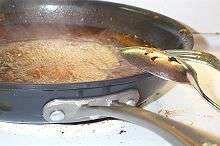Reduction (cooking)

In cooking, reduction is the process of thickening and intensifying the flavor of a liquid mixture such as a soup, sauce, wine, or juice by simmering or boiling.[1]
Reduction is performed by simmering or boiling a liquid such as stock, fruit or vegetable juices, wine, vinegar, or a sauce until the desired concentration is reached by evaporation. This is done without a lid, enabling the vapor to escape from the mixture. Different components of the liquid will evaporate at slightly different temperatures, and the goal of reduction is to drive away those with lowest points of evaporation.
While reduction does concentrate the flavors left in the pan, reducing too much will drive away all liquid in the sauce, leaving a "sticky, burnt coating" on the pan.[2]
Examples
Common preparations involving reductions include:
- Consommés, reduced and clarified stocks
- Gravies
- Gastriques, sauces involving both acidic and sweet components
- Pan sauces
- Syrups
Notes
- Sauces from basic brown sauce to Béchamel sauce and even tomato sauce are simmered for long periods (from 1 to 10 hours) but not boiled. Simmering not only develops the maximum possible flavor, but also allows impurities to collect at the top and be skimmed off periodically as the sauce cooks. Boiling diffuses the impurities into the liquid and results in a bitter taste and unclear stock.[3]
- See also Martha Holmberg, Modern Sauces (Chronicle Books, 2012), pages 199-205 and 236-38 (sauces that are simmered, not boiled). However, she also has recipes in which sauces are boiled, pages 241-42.
- The importance of simmering sauces is illustrated also in America's Test Kitchen Cooking School Cookbook (America's Test Kitchen, 2013), page 232.
- Broths are also simmered rather than boiled, and for the same reasons.[3](pp304-5)
- This is true even though some cookbook authors unwisely use the term "boiling" as a general term that fails to recognize the harm of boiling in preparation of many reductions such as stocks, sauces, etc. See, e.g., Sharon Tyler Herbst and Ron Herbst, The New Food Lover’s Companion, 5th edition (Barron’s, 2013) page 627.
References
- ↑ "Technique: Making a Sauce Reduction". The Kitchn. Retrieved May 29, 2015.
- ↑ Petrosky, Maureen C. "How To Make A Reduction". Food Republic. Retrieved May 29, 2015.
- 1 2 The Culinary Institute of America (2011). The Professional Chef (9th ed.). Hoboken, New Jersey: John Wiley & Sons. pp. 268-70 (brown sauce), page 295 (Béchamel Sauce and Tomato Sauce). ISBN 978-0-470-42135-2. OCLC 707248142.